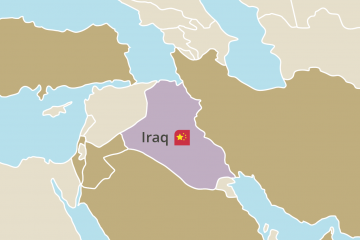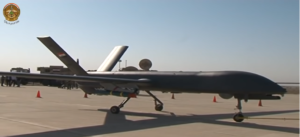
Iraq
The Iraqi Air Force, reconstructed with US guidance and support following its destruction during the 2003 invasion, is a young force, but has already seen a great deal of combat following the rise of Daesh in 2014.
Since the invasion, Iraq has pursued a very flexible strategy towards combat aircraft – acquiring them from Russia, the US, Iran and China. This has resulted in an eclectic mix of aircraft types ranging from Soviet-era Su-25 ‘Frogfoot’ ground-attack aircraft to modern US F-16 Vipers, light and heavy pattern attack helicopters, and even the AC-208 Combat Caravan (converted Cessna 208 light aircraft fitted with a sensor ball and hardpoints for twin AGM-114 Hellfire missiles). All these capabilities were acquired at high speed in a desperate rush to increase Iraq’s capability to support its ground forces in the battle to drive out Daesh – and strikes with all types were as heavy and frequent as supplies of munitions would permit throughout much of 2014–2017.
During this period, the US and the UK deployed significant numbers of MQ-9 Reaper UAVs for ISR and strike missions to aid Iraqi forces, alongside large numbers of fast jets. However, Iraq was refused permission to buy either MQ-1 or MQ-9 UAVs from the US, and therefore, in 2015, purchased at least three CH-4B armed UAVs from China (manufactured by CASC) as a rapid way to improve the air force’s persistence and ability to provide fire support to ground forces. Iraq may have subsequently acquired one or two additional airframes, although this is unconfirmed.
Armed UAV inventory

Drone
CH-4B Rainbow
Type
Medium Altitude, Long Endurance (MALE) UAV
Manufacturer
China Aerospace Science and Technology Corporation (CASC)
Number
4
Endurance
Up to 40 hours depending on payload
Loaded Weight
4500kg
Payload Capacity
345kg
Range
>1000km with SatCom, ~150km from Ground Control Station (GCS) if not.
Sensor Options
Infra-Red (IR) and Electro-Optical (EO) cameras, and laser designator in sensor ball.
Weaponry
‘A’ Variant is Unarmed. ‘B’ carries up to 345kg of payload on 4-6 wing hardpoints including: the AKD-10 air-to-surface anti-tank missile, BRMI-90 90mm guided rocket, FT-7/130 130kg glide bombs, FT-9/50 50kg bomb, FT-10/25 25kg bomb, GB-7/50 50kg precision-guided munition (PGM), and GB-4/100 PGM.
In general, the acquisition and introduction into service of the CH-4B has not changed Iraq’s airpower norms and behaviours, nor the way in which the Iraqi Air Force employs its strike aircraft, even though armed UAVs were perceived as a useful tool considering the higher-threat operating environment engendered by Daesh.
Iraq’s CH-4Bs have only ever been observed being controlled directly via ground stations as the country does not have satellite communication capabilities and the CH-4B is not interoperable with Western systems. Chinese specialists have been instrumental in early operations and training Iraqi operators to use the system since it was first unveiled at Al-Kut Airbase in October 2015.[1] The extent to which Chinese operators followed Chinese operational procedures and standards (which are still embryonic) or were directed to follow Iraqi rules of engagement is an important question that this study has not been able to answer.
Since October 2015, the CH-4Bs have been in regular use against both static targets, such as munitions caches and artillery pieces, and the extremely dangerous vehicle-borne improvised explosive devices which are heavily used by Daesh. As of mid-2018, the Iraqi Air Force claimed more than 260 strikes had been carried out by its CH-4Bs.[2] As well as being comparatively inexpensive to purchase and operate, the Iraqi Air Force appreciated the ability to purchase large numbers of low-cost Chinese AR-1 and FT-9 munitions for their CH-4Bs as needed. The slower, more formal US foreign military sales process left the country short of AGM-114 Hellfire missiles for its AC-208s early in the fight against Daesh.[3]
However, since the US considers Chinese UAVs to be a potential information security threat, the Iraqi CH-4Bs are not integrated into the coalition ISR and air operations picture, rendering them unsuitable for use in operations where Western special forces and advisers might be near Iraqi forces on the ground – such as during the Battle of Mosul.
The pressing operational imperative presented by Daesh meant that the UAVs were rapidly employed for strikes in support of friendly forces on the ground as soon as they were delivered, with little opportunity to explore specialised C2 or tasking architectures. Due to the broad range of Soviet/Russian, American, Iranian and Chinese platforms in the Iraqi Air Force inventory, the lack of CH-4B compatibility with Western C2 systems is less of a handicap than for other US-aligned countries in the region. The Iraqi Air Force is already accustomed to operating a range of platforms that are similarly not interoperable.
In terms of extra-territorial operations, it is notable that in April 2018 the Iraqi Air Force carried out strikes against Daesh targets across the border in Syria, but chose to employ its F-16s rather than armed UAV capabilities. This may be due partly to the fact that in late 2016, Iraq’s CH-4B force was moved to sit under army command, primarily due to political concerns over key air force and army leadership personalities.[4] However, since the personnel operating the UAVs have not changed – simply rebadged – this is unlikely to have a major effect on current operational norms. In general, the CH-4Bs were acquired and have been used for the same purposes as Iraq’s other airpower capabilities: to rapidly increase the firepower available to combat Daesh on Iraqi soil as fast as possible. With the diminishing threat from Daesh, it remains to be seen how the Iraqi army will use its armed UAVs, but so far there are no indications of major changes.
NOTES
[1] Arnaud Delalande, ‘Iraq’s Chinese Made Killer Drones are Actually Pretty Good’, War Is Boring, 21 February 2018.
[2] Ibid.
[3] For example, see Martha Raddatz, ‘Iraqi Military Out of Hellfires in Battle Against ISIS’, ABC News, 21 June 2014.
[4] Author telephone interview with Iraqi Air Force expert, 15 October 2018.